Thank you for Subscribing to Energy Business Review Weekly Brief
Integrating Wind Engineering Services into Renewable Energy Marketing Strategies
Integrating wind engineering services into marketing strategies enhances differentiation in renewable energy, attracting investors and ensuring stability by emphasizing financial outcomes and risk mitigation.

By
Energy Business Review | Monday, September 29, 2025
Stay ahead of the industry with exclusive feature stories on the top companies, expert insights and the latest news delivered straight to your inbox. Subscribe today.
Fremont, CA: Wind energy has emerged as a powerhouse in the global transition to sustainable power generation. As the technology matures, the competitive landscape intensifies, pushing renewable energy firms to seek robust differentiators beyond simple kilowatt-hour production. This is where the specialized, technical expertise of Wind Engineering Services becomes a critical, yet often underutilized, asset in the marketing arsenal.
Integrating wind engineering not only as a back-end technical function, but also as a forward-facing market differentiator, is key to attracting savvy investors, influencing policymakers, and securing end-user confidence.
Re-framing Engineering as a Competitive Edge
Instead of treating engineering as a back-office function, marketing should position it as the core value proposition and a powerful competitive differentiator. Wind engineering services, including site screening, wind resource assessment, and detailed project due diligence, are essential for minimizing financial risks and ensuring viable returns on investment. Rather than focusing on purely technical terms like “advanced wind flow modeling,” marketing should highlight financial outcomes—for example, emphasizing how proprietary modeling reduces uncertainty in energy yield by 15 percent, thereby securing more favorable financing terms.
Another critical dimension is grid integration and stability. Since intermittency remains a significant concern for grid operators, companies should highlight their engineering capabilities in grid-tied system design, advanced energy management software, and storage integration. By doing so, they position themselves not as turbine sellers but as providers of stable, reliable, and around-the-clock clean energy solutions. Equally important is demonstrating expertise in certifications and compliance. Independent engineering and technical advisory services play a crucial role in achieving certifications, such as UL, and ensuring adherence to complex local and international regulations. By emphasizing these capabilities, companies build credibility and trust with both regulators and financial institutions.
Leveraging Engineering Expertise for Market Leadership
Wind engineering is also a powerful driver of thought leadership when leveraged effectively in marketing. Companies can establish authority by publishing educational content, such as case studies, white papers, and webinars, that showcase how specific engineering interventions have solved real-world challenges—whether optimizing wind farm layouts for complex terrain or reducing curtailment losses. This not only educates the market but also reinforces the company’s technical edge.
Visual content plays a crucial role. Sharing behind-the-scenes videos, infographics, and detailed explanations of processes such as micrositing, foundation design, and construction monitoring demonstrates the precision and rigor of engineering practices. This transparency builds confidence in the final product’s quality and reliability. Partnerships and testimonials further enhance credibility. Collaborating with leading universities, technical advisors, and financial institutions—and sharing endorsements from independent engineers and lenders—validates the company’s technical rigor and instills confidence among stakeholders.
A strong digital and partnership strategy amplifies these efforts. Targeted advertising on platforms like LinkedIn and industry-specific networks can effectively reach policymakers, B2B clients, and investors with messages centered on ROI, risk mitigation, and grid stability. At the same time, optimizing website content for high-value, problem-solving keywords such as “wind farm feasibility studies” and “technical due diligence renewable energy” ensures visibility at critical decision-making moments. Forming alliances with utilities and financial institutions, anchored in engineering expertise, signals technical reliability and positions the company as more than an equipment supplier—it becomes a strategic partner delivering certainty, reliability, and long-term profitability.
In a market saturated with generic "green energy" claims, integrating wind engineering services into the marketing strategy provides a powerful, fact-based differentiator. It transforms technical complexity into tangible value: reduced risk, increased certainty, and optimized LCOE.
By translating the precision of wind engineering—from numerical weather prediction to fatigue analysis—into the language of investors (returns), policymakers (reliability), and end-users (cost), renewable energy firms can effectively bridge the gap between engineering innovation and market adoption, setting a new benchmark for project quality and securing a competitive edge in the evolving energy landscape.






